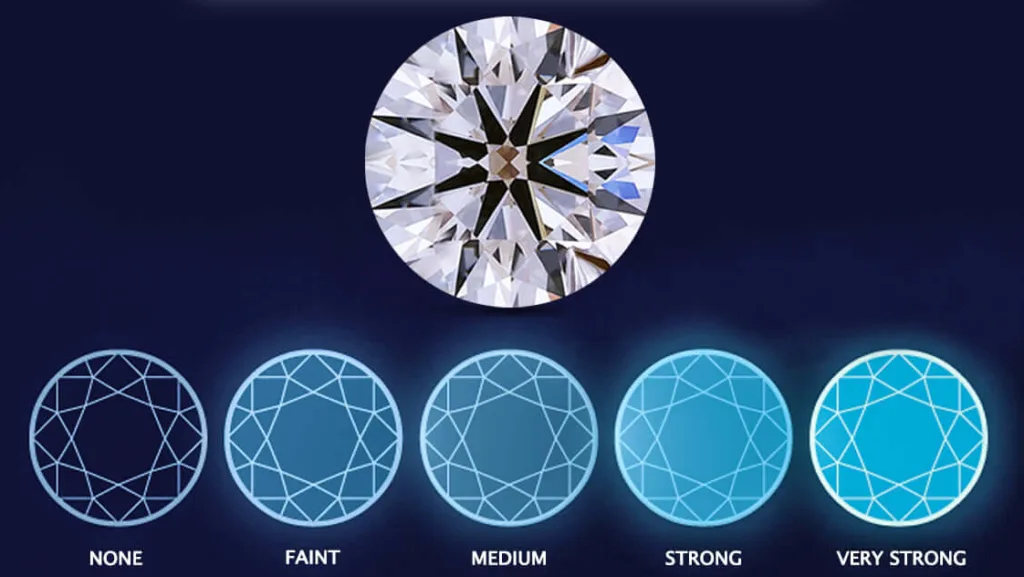1. Performing UV fluorescence Test on counterfeit diamonds
Using a UV light test is a cool trick to tell if a diamond is real or fake. Real diamonds turn electric blue under UV light, but fake ones don’t. Some diamonds might glow other colors like yellow, orange, red, or green, helping you spot them. Natural diamonds usually glow blue more often than fake ones, which is helpful. But be cautious, some treatments can affect how they glow, so it’s smart to ask an expert. The test is easy and doesn’t need fancy tools. It’s best to let a diamond expert use their equipment because the test isn’t always right.

When buying diamonds, especially ones certified by the GIA, watch out for fakes. You can check by weighing it or looking for flaws with a special tool. But the safest bet is to get a GIA Certified Diamond. They’re checked by experts and come with a stamp of approval from a trusted institute. When you buy one, you know you’re getting the real deal.
2. Using the Fog Test to Identify Fake Diamonds
A quick and easy way to tell if your diamond is real or fake is by doing a fog test. Here’s how it works: hold the diamond in front of your mouth and breathe on it, similar to how you would fog up glasses before cleaning them. If the diamond fogs up and the moisture stays for a while, it’s probably fake. Real diamonds disperse heat quickly, so the fog should disappear almost instantly. Make sure the diamond is clean and free of oil before performing this test. Note that this test only works on loose diamonds, not on jewelry.

The reason this test works is due to thermal conductivity. Real diamonds are excellent thermal conductors, which is why they are used in electronics. Lab-grown diamonds also share this property and are utilized in wafer-thin forms for circuitry. This exceptional thermal conductivity makes diamonds the best thermal conductors on Earth.
3. Identifying Fake Diamonds with the Sparkle Test
The sparkle test is a popular method for determining whether a diamond is real or fake. A genuine diamond reflects light brilliantly from every angle, creating a unique sparkle, while a fake diamond often looks dull or blurry. Fake diamonds are frequently made from materials like quartz and glass, which cannot replicate the sparkle of a real diamond.
To perform the sparkle test, all you need is your eyes. Hold the diamond up to the light and rotate it at various angles, observing the sparkles and brightness it emits. A real diamond will reflect white light exceptionally well, providing an intense sparkle. If the stone appears dull and lacks a unique sparkle, it’s likely a fake.
Keep in mind that imitation diamond materials don’t compare to real diamonds in strength, clarity, or durability. For example, cubic zirconia, a common diamond substitute, emits a noticeable rainbow of light rather than the sharp, bright sparkle of a real diamond.

For a more thorough examination, compare the diamond to a known real diamond under the same lighting conditions. Use a jeweler’s loupe to look for sharp, crisp light reflections in a real diamond, versus the softer, blurred reflections in a fake one. Real diamonds have a high refractive index, which means they bend light sharply and create a high level of internal brilliance. Additionally, try placing the diamond under a UV light; many real diamonds will fluoresce blue under UV light, while most fakes will not.
It’s important to note that the sparkle test should not be your only method of testing. Use it in conjunction with other methods, such as the fog test or the magnification test, to ensure a more accurate determination.
4. Diamond tester tool
he thermal conductivity test, also known as the diamond tester tool, checks how well a gemstone conducts heat. Real diamonds are excellent heat conductors, quickly dispersing heat evenly throughout the stone. In contrast, fake diamonds do not disperse heat as effectively and will show noticeable hotspots when the heat source is removed.

To perform the test, gently touch the diamond with a heated needle or lighter for a few seconds. A real diamond will quickly return to its original temperature without any uneven spots. If you notice hotspots, the diamond is likely fake. However, this test doesn’t work well with moissanite, as synthetic moissanite stones have similar heat dispersion properties to real diamonds.
There are various diamond testers available, so choose one that suits your needs.
5. How to test fake diamonds with water
The water test is a quick and simple way to check a diamond’s authenticity. To perform this test, fill a glass with water at room temperature and carefully drop the loose diamond into the glass. If the diamond sinks, it is real. If it floats beneath or at the water’s surface, it is likely fake. Diamonds sink in water because they are dense and heavy, while fake diamonds, typically made from lighter materials like quartz or cubic zirconia, will float.

However, not all fake diamonds float, so this test alone may not be definitive. Additionally, a real diamond should capture air bubbles when submerged in cold water due to its strong surface tension. Any floating object that does not attract air bubbles is probably fake. This test primarily helps determine the density of the diamond.
Using this easy method, you can quickly check if your diamond is real based on its physical properties.

